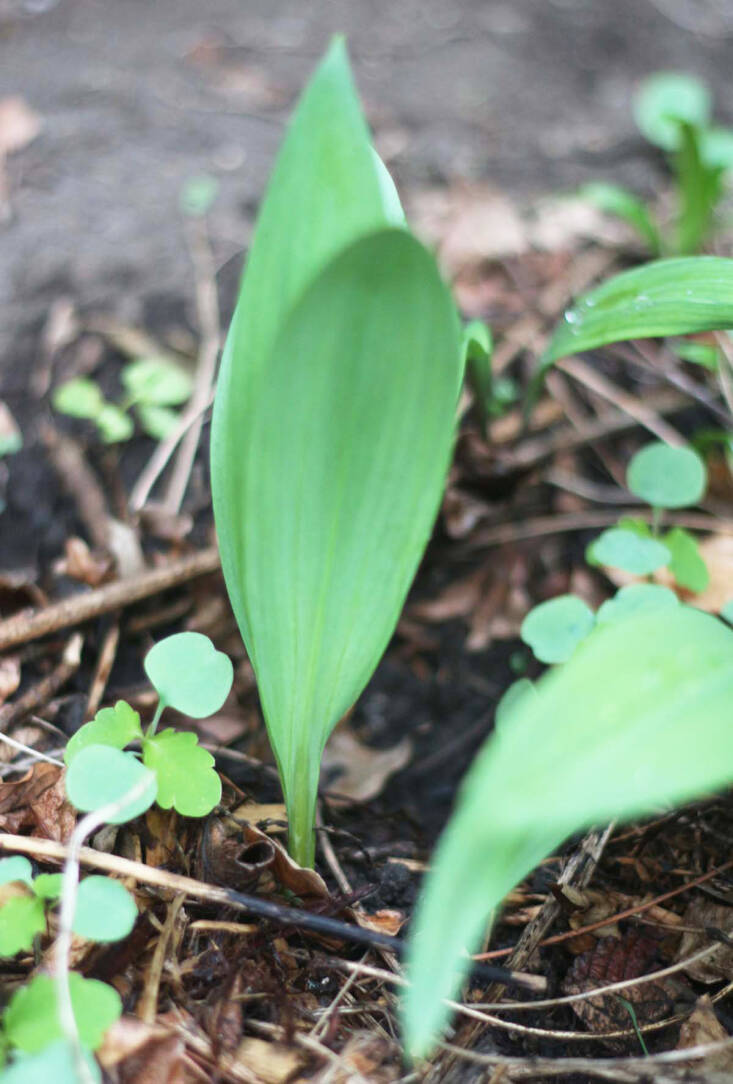In their undisturbed, native deciduous woodland home, pungently delicious ramps (also known as wild leeks) appear in extensive, green colonies in early to mid-spring. But demand for these wild onions, spring ephemerals native to eastern North America, has outpaced their life-cycle. Their over-collection for market results in brown forest floors where only occasional islands of un-dug ramps persist in the rich leaf litter. Wild ramp populations are under threat because we are consuming them carelessly. Which is why they should be cultivated.
The good news is, growing these native onions is not hard. They are a natural addition to a woodland garden, and a boon to forest farmers.
Photography by Marie Viljoen.


For a ramp conservation refresher, please visit our previous story about a woodland where the wild ramps grow.
But to sum up these onions’ life cycle: Seeds shed by the flowers of mature ramps take six to 18 months to germinate. Seedlings take about four years to produce a leaf large enough for harvest; and it takes the plant about five to seven years to form a mature bulb that can produce its own flower.
Ramps grow slowly. Humans consume quickly.

Fortunately, more and more resources are available for would-be ramp growers. Many university extensions are publishing their relatively new research.

On a tiny (but inspiring) scale I have been growing city ramps since 2016. It began with with a gift of the bulbs from a friend who collects them on his land on the Delaware River. After soaking their roots overnight in cool water they were planted in our then-backyard (whose soil pH was 5.4— quite acidic) in a spot with spring sunshine and summer shade (which mimics their natural deciduous woodland habitat). Plenty of leaf litter covered them in fall and winter. The following spring healthy leaves emerged.


When we moved to a terraced apartment, I tried again, this time with greenmarket ramps sold with roots, and soaked overnight. I planted them in a 14-inch terracotta pot, in potting soil. After one winter, one plant bloomed and set seed (no sign yet of the seedling – fingers crossed). I felt like throwing a party. This March there are five plants emerging from the cold soil that they share with foamflower and holly fern, their native woodlands neighbors. The pot spends the spring in some morning sun, then I move it beneath the shading branches of a rhododendron for the hot, humid summer.

In central New Jersey my friend Mary Rose Go, a singer, has been experimenting with growing supermarket ramps in her backyard since 2021. Her only soil amendments are mulch, and natural leaf litter from a resident oak, and her ramp rescues (from Eataly and Wegman’s) were planted in two areas: wet, and well-drained, in spots that get “sun in winter and shade in summer, just like in the woods,” notes Mary Rose. In both areas all of her supermarket ramps have come back up.

How to Harvest Ramps
Since wild ramps continue to be sold at market, and because it is possible to collect them from some thriving colonies, here is a quick primer on how to collect them, and how to advocate for their sustainable sale:
- The most sustainable way to harvest ramps is: Cut just one leaf from a mature plant. Move to the next plant.
- Second best? Thin out a dense stand of ramps by digging only the most mature bulb from a clump, leaving the smaller, younger ones that surround it, to grow.
- The best practise is to slice that mature bulb just above its roots, to do as little damage to the clump as possible.


Cheat Sheet
- Ramps are Allium tricoccum (with pink leaf-stems) and A. tricoccum var. burdickii (narrowleaf ramp; with white leaf-stems).
- Allium tricoccum‘s status is less is insecure than its narrowleafed cousin, but it is critically imperiled and vulnerable in several states.
- A. tricoccum var. burdickii is listed as critically imperiled, vulnerable, and imperiled, in several states, and Canada.
- Ramps are known mainly for their bulbs even though their leaves are packed with flavor.
- These wild onions could be collected and marketed for their leaves only (like European ramsons).
- They are collected from the wild, but can be cultivated.
- Intensive spring harvests for festivals and market are seriously harming many wild populations.
- Ramp seeds can take 6 to 18 months to germinate
- They produce a flower (to make seed) after approximately 7 years.
- If an entire clump is dug out, it will not recover until any dispersed seed matures (7 to 10 years).
- Bunches of ramps at market with the woody rootstock left attached have not been sustainably harvested.
- Native wildflowers are impacted when unscrupulous commercial foragers wipe out a ramp patch.

Keep It Alive
- Ramps like slightly acidic soil.
- They are hardy from USDA zones 4 – 7
- Humus-rich, moist soil mimics their deciduous-forest habitat.
- Mulch ramps with deciduous leaf litter.
- The plants require spring sunshine and summer shade.
- If you already grow foamflower, violets, wake robin, trout lily, or cutleaf toothwort, just add ramps.
- If you grow hostas? Your garden is ready for ramps.
- Plant in-ground, or in raised beds or pots.
- They relish and require moisture but need good drainage.
Have you grown ramps? Tell us about it in the comments!









Have a Question or Comment About This Post?
Join the conversation